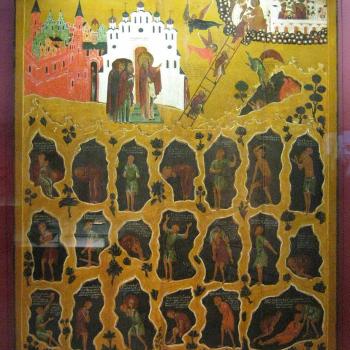Philosophical (essential and existential) doubts about the existence of God certainly feed into the practical atheism we see around us. However, the structural formation by which this practical atheism developed comes not only from philosophical doubt, but also theological error. Ancient Christians, in combating the gnostics, saw the integration of heaven and earth in the incarnation as what fundamentally linked God to the world. God is not separate from us; he has come before us, to meet us where we are at. He even has become one of us. And just as the hypostatic union is never to be broken, the relationship it established between God and the world will never end. Gnostics believed the world, as it exists, was flawed, even unreal. True life, eternal life, would come once we have entirely separated ourselves from the world and all that it offered. God revealed himself through things of the world to enlighten us, but did not enter it in any true sense. God and the world of experience are entirely separate. It’s easy to see how such a view could quickly lead to the rejection of God and the primal acceptance of the world of experience. The world is, after all, what we experience, so how can we deny its reality? On the other hand, how do we know God is even real if he is so far off that we can’t experience him here? It’s clear why Christian forcefully rejected this view, and instead, saw God and the world linked together in a non-monistic, non-dualistical integration. God perfects nature; the world, created in and by him, finds its authentic end in him. The world is real, and has a real place in the kingdom of God.
The proper understanding of the relationship between the heavenly and temporal realms, between super-nature and nature, was eventually lost, and gnostic separation between the two became the norm in theological speculation (even if, of course, gnosticism was always officially rejected). Both Protestants and Catholics, since the time of the Reformation, have often fallen for this error.[1]Dualistic thinking, to be sure, is quite apparent in the Protestant tradition: grace vs. works, God vs. man, predestination vs. free will. Instead of trying to ascertain the unity which underlies such paradoxes, Protestantism has divided them, cleaning away what it cannot understand by its sense of reason, ending, of course, with its creation of a secular world which becomes our normal daily experience, and a religious life where we can find brief encounters with God. Nature and super-nature, secular and spiritual, experiences are divided. God’s presence to the world is, like with the gnostics, to inspire us and provide for us the encouragement to follow him so we can have an other-worldly enjoyment of God after death. God, pushed aside so far in such a systematic, just takes one more shove to totally be ignored and taken out of our experience of the world. Such of course, is what often happens.[2]
Catholics, to be sure, have not faired much better. While theological tradition had told them not to, theologians slowly divided the universe into two distinct spheres, with the secular sphere as being seen, more or less, as self-sufficient and a proper end in itself. Looking with hindsight, one can both understand why this happened, sympathize with the theologians who created this situation, and even see the good work they did in their time, while also realizing past solutions to a real theological problem only put off the discovery of a proper solution to later time. The problem, of course, was the question raised by Michel Baius, and the solution was the belief of the so-called “pure nature” by which humanity (and the world) existed on its own without the influence of God.[3]
Baius understood humanity was ultimately dependent upon God. But he also believed such dependence required a response from God. Since we were created by God and for God, we had every right to expect God’s action upon us to help us attain to our proper end, which was himself. This led to the conclusion that grace was not the free and unexpected action of God towards us out of his love for us. Since we were made in such a way that we were able to receive God’s grace, and that we needed that grace, God must fulfill that need. Theologians understood there was something wrong here: one cannot make demands on God. However, the way his critics solved the problem was through the problematic hypothesis of “pure nature.” To be sure, this hypothesis predated Baius, but it had not yet achieved a central position in Catholic theological circles; it was, until then, one speculative notion among many. But once it became a tool for theologians to answer a specific heresy, its became a normative theological position for centuries.
What exactly is this concept of “pure nature”? To put it simply, it is the belief that that humanity had been created in its own “natural” sphere of existence, capable of living and being in that sphere of existence, and finding its real end in there without having any contact with God or God’s bountiful grace. Thus humanity, as it was originally created, was self-sufficient in itself.[4] Grace is a supernatural aid, given by a free God, to help fallen humanity. But our end could have been where we started, in the natural sphere. “This was originally intended simply as an auxiliary construct, a conceptual hypothesis, enabling theologians to grasp the gratuitousness of grace. But it led in turn to the development of a twofold order of natural and supernatural theology. This elaboration of something initially proposed simply as a conceptual possibility is intelligible only in the light of the indirect influence exercised by a new understanding of natural theology that developed in the modern Enlightenment.“[5]Henri de Lubac explains quite well the ramifications of this development, both in its positive content, but also in its real failure to deal with the root problem. “In this way something was added to the naturalist conception, which was neutralized by being completed with a supernatural theory, but it was not corrected or changed in itself. What was maintained, or made more explicit, was more than a necessary duality; a dualism was established according to which in practice positions could be held which were radically opposed to the conclusions that the Jansenists derived from their principles. But rather than refutation, the dualism stood out on analysis principally as a compromise.“[6]
It is not difficult to see how this concept of a purely natural sphere of influence for humanity, untouched by God, could quickly be turned, like with Protestant dualism, into a deism and then atheism. For deism, whatever its source for the individual deist (in Protestant or Catholic cosmologies), the God question quickly becomes irrelevant. Whether God exists or does not exist matters not since the world is on its own. The whole secular thesis of modern society agrees with this. Practical atheism, thus, agrees with theological dualism. God is denied any action in the public sphere. Whether God is practically or actually denied makes no difference. “Atheism commands attention and imposes itself on all by its universal diffusion. It is no longer the privilege of an enlightened minority, but expresses a norm common to all levels of society. A civilization has been built on the conscious rejection of God, or more precisely, on the negation of all dependence on any transcendent power.“[7] And since theology has found a way to negate that dependence, it is not hard to see how theology has helped contribute to the problem of atheism.
Footnotes
[1] Theological errors or mistakes, when found in the writings of the theologians, tend to trickle down to the public, even if the public does not read the theologians themselves. Discussions about God will be judged and corrected by those who do study theology (even if it takes some time for the theologians to be heard); if those in the know are confused, then their ability to help the public will suffer. A poor theological hermeneutic can blind theologians so they won’t see the needs of people around them. When this happens, it is not long before a community faces a spiritual crisis. Once a hermeneutic has been set loose into the world, it becomes difficult to control. People from all walks of life are capable of following its dictates. Since even a good, mostly sound theological reasoning, can end up with disastrous, unforeseeable consequences, all the more deadly is the effect of a theological mistaken as it becomes part of a theological tradition.
[2]Calvinistic theology certainly is a good example of this. As Alister McGrath points out, its theological tradition can easily become secularized. “Latent within Calvinism is a purely profane approach to life, in the failure to maintain a proper dialectic between God and the world leads to the collapse of the divine into the secular. Calvinist moral, economic, social and political structures and values, although firmly grounded in theology, could all too easily become detached and independent from those theological foundations. The emancipation of such structures and values from faith itself through cultural erosion is one of the most significant aspects of the Western reception and assimilation of Calvinism, especially in North America,” Alister McGrath. Christianity’s Dangerous Idea (New York: HarperOne, 2007), 323.
[3] To keep things brief, my overview here will be as brief as possible. Thus the theological explanations, pro and contra to the concept of pure nature, will not be given in any depth.
[4] Interestingly enough, Peter Lombard, centuries earlier in The Sentences, provided the means by which one could respond to the question. His work could have allowed theologians to see the error behind the concept of “pure nature” while appreciating the positive insights it was trying to display. “Wishing to remove the seeming contradiction of these authorities, we say that the virtues are to be sought and loved for their own sake, and yet only for the sake of beatitude. They are to be loved for their own sake, because they delight those who possess them with a sincere and holy delight and give birth in them to a spiritual joy. However, we are not to stop here; we must climb higher. Do not let the course of love end here, nor let this be the limit of delight, but let this joy be related to that highest good, to which alone we must adhere wholly, because it alone is to be loved for its own sake and nothing is to be sought beyond it, since it is the highest end. — And so Augustine says we love the virtues for the sake of beatitude alone, not because we do not love them for their own sake, but because we refer our very love of them to that highest good, to which alone we are to adhere and in which we are to remain and place the summit of our joy. And so it follows that the virtues are not to be enjoyed,” Peter Lombard. The Sentences. Book I: The Mystery of the Trinity. Trans. Giulio Silano (Toronto: Pontifical Institute of Medieval Studies, 2007), 10 [I-3.9] In this text, Peter Lombard was discussing how virtues are not things to be enjoyed (ends in themselves) but things to be used to attain to an end. But he admits, in a way, virtue can also be seen as an end, for it is a good. And in that way people enjoy virtue. Thus virtuous behavior must be seen as a relative end, because it is what we are to aim for in our actions; but these natural virtues can never be our proper end. They can only point to it. Any humanity existing in itself without divine intervention can never reach the final and real good, for that is God. But if God did not open himself to us, these virtues can be used for a relative enjoyment.
[5] Walter Kasper. The God of Jesus Christ. Trans. Matthew J. O’Connell (New York: Crossroad, 2003), 74.
[6]Henri de Lubac. Augustinianism and Modern Theology. Trans. Lancelont Sheppard (New York: Crossroad Publishing Company, 2000), 240.
[7]Paul Evdokimov. Ages of the Spiritual Life. Trans,. Sister Gertrude. Revised by Michael Plekon and Alexis Vinogradov (Crestwood, NY: St Vladimir’s Seminary Press, 2002), 21.
















